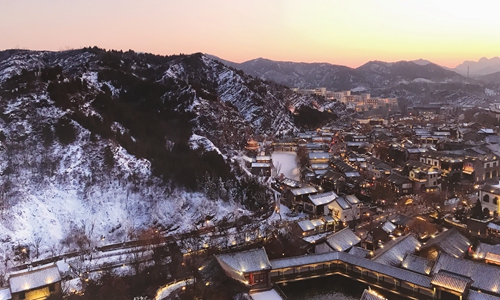HOME >> ARTS
Beijing Wtown, a shining light at the foot of the Great Wall
By Chen Xi Source:Global Times Published: 2019/12/12 10:33:40

Beijing Water Town International Tourism Resort Photo: Chen Xi/GT
Hundreds of years ago, Gubeikou, an important military chokepoint preventing invaders from Northeast China from entering Beijing, found itself at the center of numerous battles, especially during the Liao (916-1125) and Jin dynasties (1115-1234). It was due to these frequent invasions that the Great Wall was built. Many tribes left their cultural marks in this place of great military importance, forming the special multi-cultural Gubeikou village, which became the foundation for the modern Beijing Water Town International Tourism Resort (Beijing Wtown).
Built in 2014, Beijing Wtown restores the original appearance of the village during the Ming (1368-1644) and Qing (1644-1911) dynasties.
It was a cold sunny day when I arrived at the town. As the resort is located 155 kilometers from the capital, it took me an hour and a half to reach my destination by shuttle bus.
A week before my trip, Beijing saw the first snow of the winter. While this snow had quickly melted in the city, it was still everywhere in the town. The natural pure white snow on the mountains and the roofs of the buildings and the nearby river formed a harmonious view in front of me, making me want to see more of the ancient town.
World wonder
One of the most representative scenic spots in China, the Simatai Great Wall lies to the southeast of Beijing Wtown, attracting many tourists from all over the world with its steep steps, beautiful scenery and strange and diverse architectural styles.
According to an introduction to the scenic spot, the Simatai section of the Great Wall was originally built during Northern Qi Dynasty (550-577) and was rebuilt during the Ming Dynasty. It is a total of 5.4 kilometers in length and has 36 watchtowers. A World Heritage Site, the Simatai Great Wall is built on a razor-sharp ridge, offering visitors a thrilling and exciting view of the area.
A local tour guide, Liang Ge, told me that many tourists, especially visitors from Europe and India like to carry a sleeping bag when climbing the mountain.
"They often ask me and double-check with me to see if they are allowed to sleep on the Great Wall. I can always tell how excited they are when they see the Great Wall," Liang said, going on to note that no one is allowed to sleep on the Great Wall due to safety reasons.
Traditional culture
Besides the marvelous Great Wall, Beijing Wtown itself is also full of traditional Chinese elements. One of the most interesting parts is the Zhenyuan Escort Agency.
Liang told me that the agency was sort of an ancient version of a security company that provided bodyguards to protect property or people, and that it eventually developed into a modern logistics company. The house once belonged to the leader of the company, Zhang Zhenyuan, who once protected the Guangxu Emperor, the 11th emperor of the Qing Dynasty (1644-1911), as he escaped from Gubeikou.
The house was very big, and what surprised me most were the exquisite decorations, including a delicate vase and tea pot, scattered around the home of such a tough guy. The yard was the place where Zhang practiced his kungfu and also included a big stage for kungfu tournaments and a plum tree. Standing in the yard, the Great Wall seemed so close. I started to imagine that Zhang might have known the ancient Chinese martial art known as qinggong, which would enable him to regularly fly to the Great Wall to check for any invaders.
Another interesting place was a matchmaker's temple. Liang told me that while Beijing Wtown is a tourist spot, it was rebuilt on the foundation of the old villages and towns in the area. For example, the ancient matchmaker's temple had been around for a long time. In the past, many young couples would come to pray to the matchmaker statue - a white-haired old man with a smiling face, for an ideal marriage. I asked Liang if the tourism group kept the temple around due to the feng shui. She laughed but did not refute my guess. She also said they take care of the many cats that have lived in the place for a long time.
"We often joke that the oldest residents in Beijing Wtown are the local cats," Liang said with a smile.
Melting pot
Due to the special location of Gubeikou, the ancient people living there came from different cultural backgrounds and gradually formed a multi-cultural place.
"We have Buddhist culture and Catholic culture from our local ancestors, and Protestant culture from our current Christmas-themed activities," Liang said.
The Yuantong Temple Tower is located on a hill in Beijing Wtown. The tower is seven stories high with two underground levels and is a place for meditation. Liang told me that visitors can enjoy activities such as copying Buddhist scriptures and drinking tea. She also pointed at a hill and told me a Catholic church was built at the top.
"The church has a choir that sings Christmas carols, and sounds incredible during wedding ceremonies," Liang said.
Since Christmas was right around the corner, the town was full of Christmas decorations including a holiday market, Christmas tree and even a holiday-themed unmanned aerial vehicle show.
During the show, hundreds of UAVs carrying Sky Lanterns flew through the sky, flashing red lights and lighting up the dark night. Following the lantern show, another group of UAVs appeared in the sky and began forming different shapes including an image of Santa Claus, spelling out Merry Christmas and the year 2019. I had never seen such a sight before so I immediately whipped out my phone to record this unforgettable moment.
Beijing Wtown is indeed a place that I think I will return to every season.
Newspaper headline: Ancient gateway
Posted in: CULTURE & LEISURE